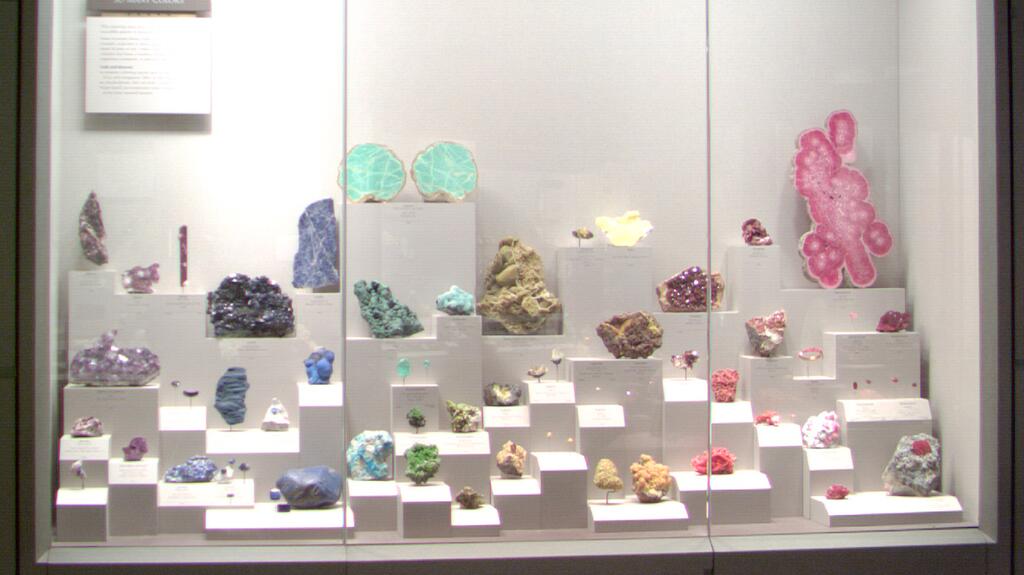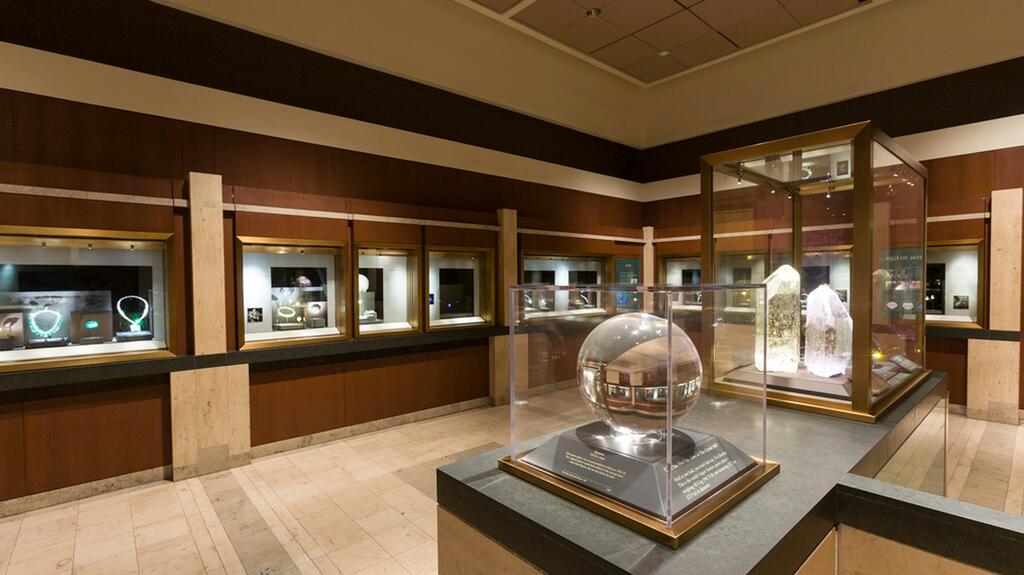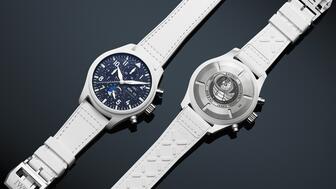Meet the Smithsonian’s New Curator of Gems and Minerals
Dr. Gabriela Farfan has big plans for the museum’s collection of 10,000 gemstones and 385,000 mineral specimens.

She brings a wealth of knowledge to the role, including a Ph.D. from MIT.
However, Farfan’s story starts long before she reached the Ivy League, as her fascination with gems and minerals started at a young age.
She took over as curator in May, when the former curator of the collection, Dr. Jeffrey Post, stepped down after nearly four decades with the institution.
This was my first time visiting the museum.
While at the north entrance waiting for Farfan to meet me, I found myself drawn to the Berns Quartz, which stands 7 feet tall and weighs more than 8,000 pounds. Because the mineral was discovered at the Coleman mine in the Ouachita Mountains of Arkansas, not far from where I grew up, I took it as a good omen.
Farfan insisted that because I’d never been to the museum, we should first do a walkthrough of the gems and minerals hall.
The entrance to the hall, the Harry Winston Gallery, is marked by a tall case holding, on a rotating lit pedestal, the historic Hope Diamond.
The Hope Diamond hasn’t always occupied this spot. Back in the day, Farfan explained, it was at the end of the hall, causing visitors to anxiously rush through the exhibits in anticipation of seeing the blue diamond.
It was moved to the front around the time of the hall’s 1997 renovation.
“Everyone gets to see [the diamond]. They get calm, they’re not stressed that they haven’t seen it yet, and then they’re ready to actually experience the rest of the exhibits,” said Farfan.
As we walked, Farfan shared other interesting facts like how Janet Annenberg, the philanthropist for whom the hall is named, and her sisters convinced each other to donate their jewels to the Smithsonian.
“Not a single taxpayer dollar goes into purchasing gems or minerals,” she told me. Everything is a gift, donation, or purchased with the endowment fund.
She gestured toward an emerald crystal, donated by Harry Winston, continuing, “and occasionally, we like to show people that gemstones do come from crystals, from minerals.
“We recognize the need to preserve some of these major crystals that would otherwise get converted into smaller gemstones [and] to show the public, you can get these large gems because you have large flawless crystals.”
Shortly after, we came to a case featuring a vibrant display of specimens, organized in the colors of the rainbow.

“We like to show the basic properties of minerals, starting with colors and shapes,” said Farfan. “We don’t try and overwhelm [visitors] with chemistry and everything quite yet. But we show the variety of minerals naturally occurring in the Earth. People love our color case, because it’s amazing. You can see the full rainbow.”
The details of how the public experiences the exhibits is a big consideration, she said.
“It’s a perfect marriage of science and art, putting them together in a really meaningful way that connects with people in a very unintimidating way that gets them excited about science, because when they see something that inspires awe, they want to learn more about it.”
She noted that the changes made in the renovation, though it’s now been over 25 years, have withstood the test the time. It was Post, not Farfan, who was running things back in 1997.
At that time, Farfan was a young girl, her passion for the sciences budding. Originally from Wisconsin, she would travel out West with her dad to go mining.
“Along the way, oftentimes artists [would] also visit these mines to get sunstones or other minerals to make their creations out of,” she said, adding that this is how she met some of the artists and gem cutters now in her professional network.
“I realized that I loved minerals and gemstones from the time I was about 6 years old, and I knew shortly afterward I wanted to become a minerologist. My goal was to do that in the best possible way.”
In high school, Farfan worked on a project on Oregon sunstones while doing research with mentors at the University of Wisconsin, and that’s when things really began to click.
“That [project] was my first introduction to mineralogical research and gemological research, and I realized this is what I wanted to do for the rest of my life,” she said.
Farfan visited the National Museum of Natural History for the first time at 16 years old, and before she arrived, she’d reached out to Post.
“I asked if I could meet him because I was so interested in gems and minerals that I thought it would be a treat to get to meet the curator of gems and minerals at the time,” she said.
After that meeting, they kept in touch about her education and her career. He even wrote her letters of recommendation.
Farfan went on to get her bachelor’s degree in geological and environmental sciences from Stanford University and her Ph.D. from the Massachusetts Institute of Technology–Woods Hole Oceanographic Institution Joint Program in Oceanography/Applied Ocean Science and Engineering.
While in graduate school, she volunteered at the Harvard Mineralogical Museum, and for the past few years, she’s been working at the Smithsonian in D.C.
Back in her office, she told me her focus today is mostly on biominerals, explaining that she pairs traditional mineralogical research with considerations of how biology plays a role in some mineral structures.
“I also do classical minerology, but the main focus of my research is to look at biominerals, like shells and skeleton and corals, and understand how changes in their local general environment can influence their crystal structures, on an atomic scale.”
Her future plans include bringing this meeting of the sciences to its own dedicated exhibit, which the museum currently does not have.
Her job as curator involves internal happenings at the museum such as active research, collecting data, and writing papers and proposals. But another part of her role is very much external—dedicating time to the displays.

She and her team are continually searching for ways to expand and enhance the gem and mineral collection. They visit the Tucson gem and minerals show each year, hunting for worthwhile additions.
“We keep an open mind, because there are always new things that appear on the market, so we’re always trying to find what’s newly mined that year,” she said.
The two collection managers have been in their positions for 40 years each, she said, so when they go “shopping,” the managers know what they have and what they don’t have in the collection, which includes 10,000 gemstones and 385,000 minerals.
“We’re looking for holes in our collection, so if there’s something that’s been missing, we try and specifically search for that. Sometimes it might be an old discovery from someone whose had it tucked away for many, many years and now is willing to sell it.”
Farfan told me that just the day before our interview, a woman came into the museum with specimens she had dug up herself and wanted to donate some pieces.
“We talked to her about her experience for a while, and we ended up accepting a few specimens from her,” Farfan said.
However, with an institution as large as the Smithsonian, making changes isn’t easy, as they often involve consulting multiple departments. But when they do happen, it’s all for the visitor experience.
“Sometimes [we add] new discoveries. Oftentimes, it’s an upgrade,” Farfan said.
“If we get a larger, more beautiful spinel, we might decide we’re going to replace the [existing] stone with the bigger and better version. Our goal is always to show our best pieces on exhibit.
“What’s the point of having them behind the scenes if no one can appreciate them? We want the world and the American people to experience the best of the best. It’s my job to make sure that happens.”
There’s still much to learn as the exhibits evolve and as she grows in her position, Farfan said.
“It’s only been in recent years that I think our team has realized the power of gems in jewelry for engaging the public,” she told me on the behind-the-scenes part of the tour where I got to see the gems currently tucked away from public view.
(At this point, I was drooling over the “De Beers Cullinan Blue” diamond necklace.)
She said she’s been taking lessons from one of the museum’s consultants on jewelry history, so when new pieces come in, she’s prepared to speak on them.
“It’s not something I’m trained in as a scientist at all,” she said of jewelry history.
“If you show me your ring that has a cool gem in it, no matter how expensive or cheap it was, I will get excited about it. It’s still interesting. I don’t think I’ll ever be jaded.” — Dr. Gabriela Farfan
Despite all the challenges, when Farfan said being curator of the country’s official gem and mineral collection was her dream job, she meant it.
“I think the Smithsonian, especially our National Museum of Natural History, is a very special place to work. And I feel very privileged to be in this position and I foresee being in this career a long time,” she said. “Everything we see is special.”
At the end of our interview, I ask her if she thinks she’ll ever get used to being surrounded by such treasures each and every day, and she tells me she has two separate brains.
“I have my Smithsonian gem and mineral brain where I have to assess what is best for the collection, like if it’s ‘good enough,’ but I still have my personal side of the brain which is, if you show me your ring that has a cool gem in it, no matter how expensive or cheap it was, I will get excited about it,” she said.
“It’s still a mineral. It’s still a gemstone. It’s still interesting. I don’t think I’ll ever be jaded.”
No pun intended.
The Latest

Said to be the first to write a jewelry sales manual for the industry, Zell is remembered for his zest for life.

The company outfitted the Polaris Dawn spaceflight crew with watches that will later be auctioned off to benefit St. Jude’s.

A buyer paid more than $100,000 for the gemstone known as “Little Willie,” setting a new auction record for a Scottish freshwater pearl.

Supplier Spotlight Sponsored by GIA.

Anita Gumuchian created the 18-karat yellow gold necklace using 189 carats of colored gemstones she spent the last 40 years collecting.


The giant gem came from Karowe, the same mine that yielded the 1,109-carat Lesedi La Rona and the 1,758-carat Sewelô diamond.

The three-stone ring was designed by Shahla Karimi Jewelry and represents Cuoco, her fiancé Tom Pelphrey, and their child.

Supplier Spotlight Sponsored by GIA

The Manhattan jewelry store has partnered with Xarissa B. of Jewel Boxing on a necklace capsule collection.

Acting as temporary virtual Post-it notes, Notes are designed to help strengthen mutual connections, not reach new audiences.

The jewelry historian discusses the history and cultural significance of jewelry throughout time and across the globe.

From fringe and tassels to pieces that give the illusion they are in motion, jewelry with movement is trending.

The designer and maker found community around her Philadelphia studio and creative inspiration on the sidewalks below it.

The change to accepted payment methods for Google Ads might seem like an irritation but actually is an opportunity, Emmanuel Raheb writes.

The industry consultant’s new book focuses on what she learned as an athlete recovering from a broken back.

The fair will take place on the West Coast for the first time, hosted by Altana Fine Jewelry in Oakland, California.

Hillelson is a second-generation diamantaire and CEO of Owl Financial Group.

Submissions in the categories of Jewelry Design, Media Excellence, and Retail Excellence will be accepted through this Friday, Aug. 23.


Known as “Little Willie,” it’s the largest freshwater pearl found in recent history in Scotland and is notable for its shape and color.

Clements Jewelers in Madisonville cited competition from larger retailers and online sellers as the driving factor.

The gemstone company is moving to the Ross Metal Exchange in New York City’s Diamond District.

Most of the 18th century royal jewelry taken from the Green Vault Museum in Dresden, Germany, in 2019 went back on display this week.

The Pittsburgh jeweler has opened a store in the nearby Nemacolin resort.

With a 40-carat cabochon emerald, this necklace is as powerful and elegant as a cat.

The Erlanger, Kentucky-based company was recognized for its reliability when it comes to repairs and fast turnaround times.

Unable to pay its debts, the ruby and sapphire miner is looking to restructure and become a “competitive and attractive” company.

The trend forecaster’s latest guide has intel on upcoming trends in the jewelry market.




























